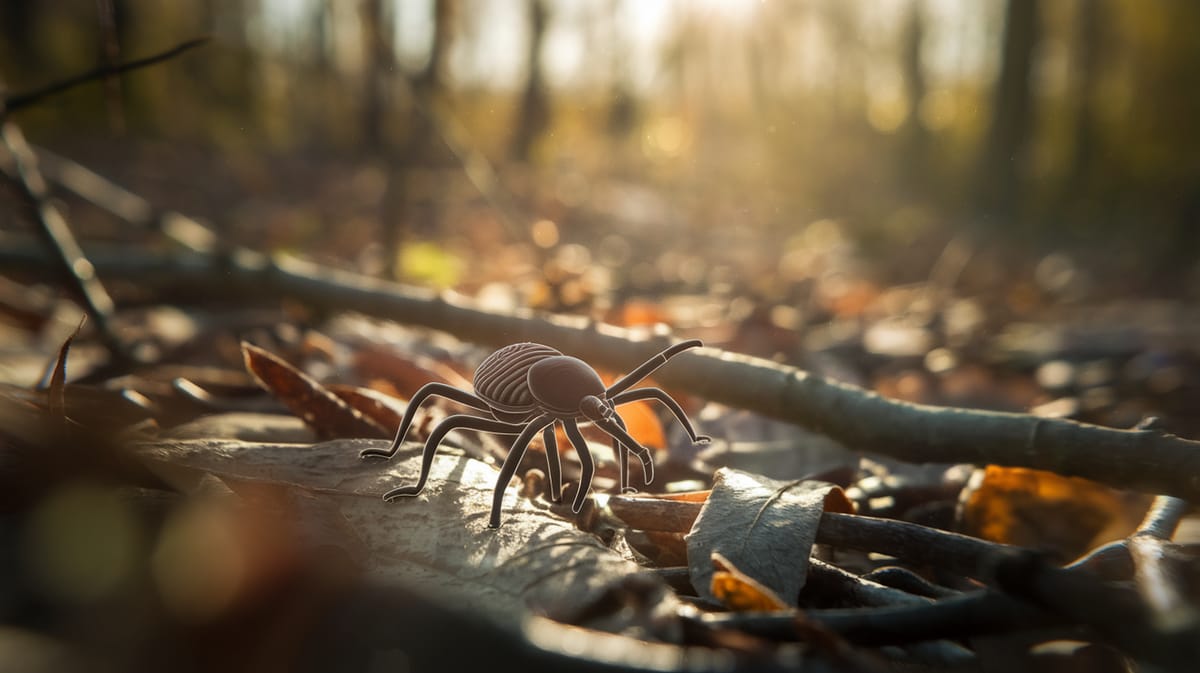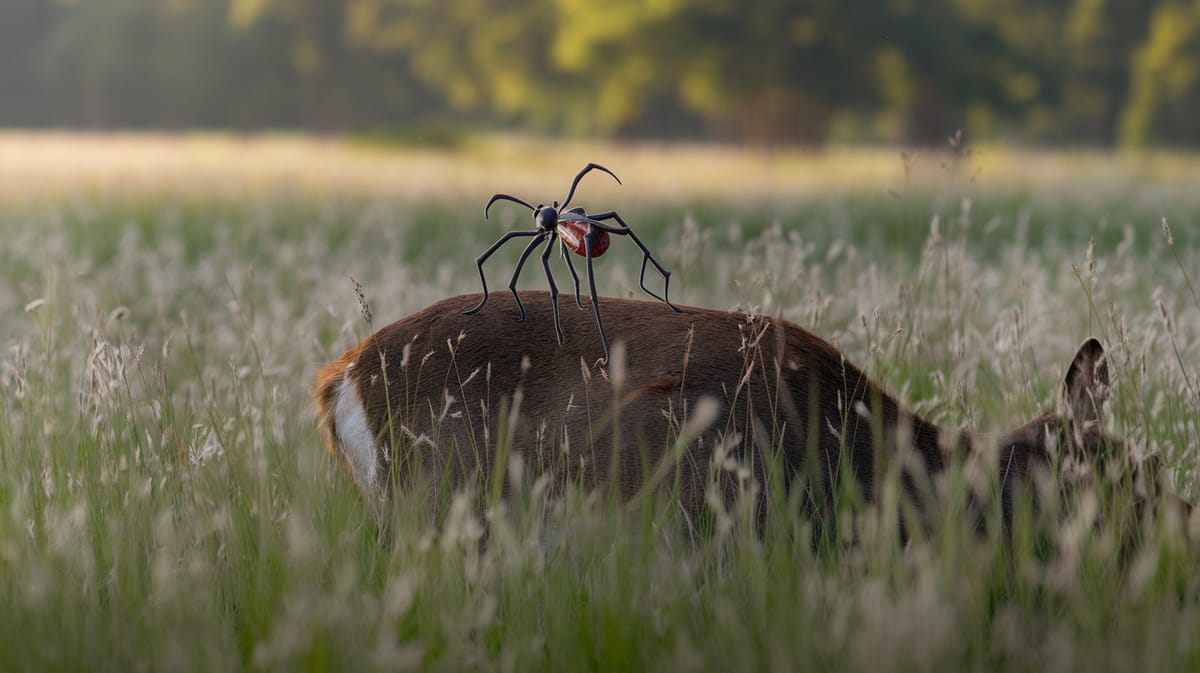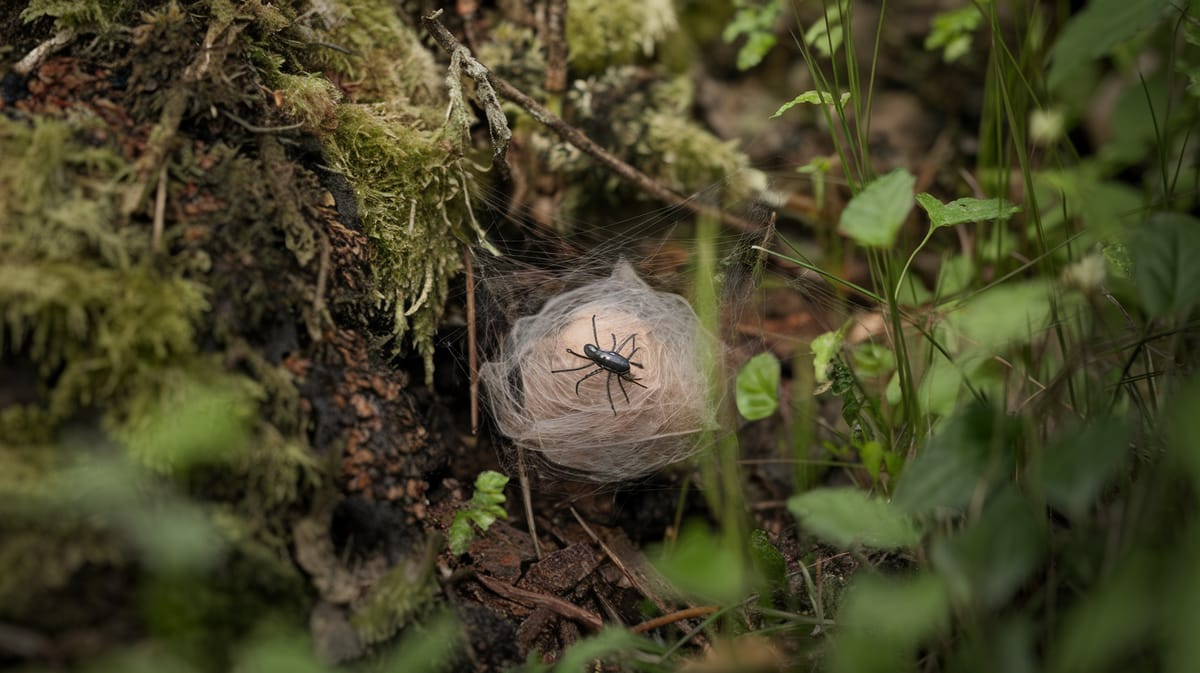Lone Star Tick
Known for its distinctive white spot, the Lone Star Tick is a relentless questing insect, actively seeking hosts to feed on. Its role in spreading diseases underscores its ecological impact.

Key Insights at a Glance
Did You Know?
Taxonomy & Classification
The Lone Star Tick is a highly adaptive arachnid known for its aggressive feeding behavior and significant role in spreading diseases in both humans and animals. Let's understand the evolutionary journey and classification of these remarkable parasites.
Species Diversity
The Amblyomma genus, which includes the Lone Star Tick, comprises over 100 species globally, highlighting a wide range of ecological adaptations.
Evolutionary Origins
Originating in North America, Lone Star Ticks have thrived by adapting to various climates, expanding their range considerably over recent decades.
Lifecycle and Growth
A remarkable journey of transformation from Egg to Adult.
Egg
Laid in clusters, eggs develop within a protective layer until hatching, marking the beginning of the tick's lifecycle.
Larva
Known as seed ticks, larvae emerge with six legs and seek small hosts to feed on blood for development.
Nymph
After molting, nymphs gain additional legs and search for larger hosts to sustain their growth and advance to adulthood.
Adult
Adults, fully grown with eight legs, focus on feeding and mating, with females laying eggs to continue the cycle.
Dietary Habits
An adept blood feeder with specialized mouthparts, this arachnid targets mammals, birds, and occasionally reptiles for sustenance.
| DIET TYPE | DESCRIPTION |
|---|---|
| Primary Diet | Primarily feeds on the blood of mammals such as deer, humans, and domestic animals. |
| Secondary Diet | Consumes blood from birds, utilizing its ability to detect carbon dioxide and heat. |
| Occasional | Occasionally feeds on reptiles and amphibians when other hosts are scarce or unavailable. |

Behaviour and Adaptations
Discover the fascinating adaptations that define the Lone Star Tick’s survival strategies.
Host Detection
Uses carbon dioxide detection to locate hosts effectively.
Questing Behavior
Climbs vegetation and extends legs to latch onto passing hosts.
Saliva Secretion
Injects saliva to prevent blood clotting in hosts, aiding feeding.
Ecosystem Impact
Supporting biodiversity and maintaining ecological balance.
Host Regulation
Controls host animal populations by feeding on their blood.
Disease Vector
Transmits pathogens, influencing wildlife health dynamics.
Food Source
Serves as prey for birds and other insects.
Conservation Challenges
Understanding and addressing the key threats to Lone Star Tick populations.
Chemical Exposure
Pesticides reduce tick survival and disrupt ecosystems.
Habitat Fragmentation
Urban development limits tick habitats and food sources.
Climate Change
Altered weather patterns affect tick distribution and life cycles.
Frequently Asked Questions
How long do Lone Star Tick live?
Lone Star Ticks typically live for about two years, but this can vary depending on environmental conditions. Their lifecycle includes three stages: larva, nymph, and adult. Each stage requires a blood meal from a host to develop to the next stage.
What do Lone Star Tick eat?
Lone Star Ticks feed on the blood of various hosts, including mammals, birds, and reptiles. They are not picky and will attach to humans if given the opportunity. They require a blood meal at each lifecycle stage to grow and reproduce.
Are Lone Star Tick poisonous?
Lone Star Ticks are not poisonous, but their bites can cause allergic reactions in some people. They are known for transmitting diseases such as ehrlichiosis and can potentially cause a red meat allergy, known as alpha-gal syndrome, in some individuals.
Are Lone Star Tick endangered?
Lone Star Ticks are not considered endangered. They are prevalent in the southeastern United States and have been expanding their range northward and westward. They thrive in wooded areas and places with dense underbrush where they can easily find hosts.
What do Lone Star Tick symbolize?
Lone Star Ticks do not have a symbolic meaning in the cultural or mythological sense. They are primarily viewed as pests due to their role in transmitting diseases and causing allergic reactions through their bites.
Do Lone Star Tick bite?
Yes, Lone Star Ticks do bite. They attach to their hosts to feed on blood, which is necessary for their development through life stages. Their bites can cause irritation, allergic reactions, and the transmission of diseases to humans and animals.
What color are Lone Star Tick?
Lone Star Ticks are reddish-brown. Adult females are easily identified by a distinctive white spot on their backs, which gives them their name. Males do not have this spot and are uniformly dark brown.
Does a Lone Star Tick have wings?
Lone Star Ticks do not have wings. They are arachnids, similar to spiders, and rely on crawling to move. They typically wait on grass or shrubs and latch onto passing hosts for feeding.
What does a Lone Star Tick look like?
Lone Star Ticks are small, reddish-brown arachnids. Adult females feature a single white spot on their back, while males are uniformly brown. They have eight legs and a flattened, oval body, typical of ticks.
Is a Lone Star Tick an insect?
No, a Lone Star Tick is not an insect. It is an arachnid, a group that includes spiders and scorpions. Arachnids have eight legs, unlike insects, which have six. This group also lacks wings and antennae, distinguishing them from insects.
Related Insects
Discover insects with similar characteristics to Lone Star Tick - including shared habitats, diets, and taxonomic classifications
Share this profile
Help others discover Lone Star Tick
